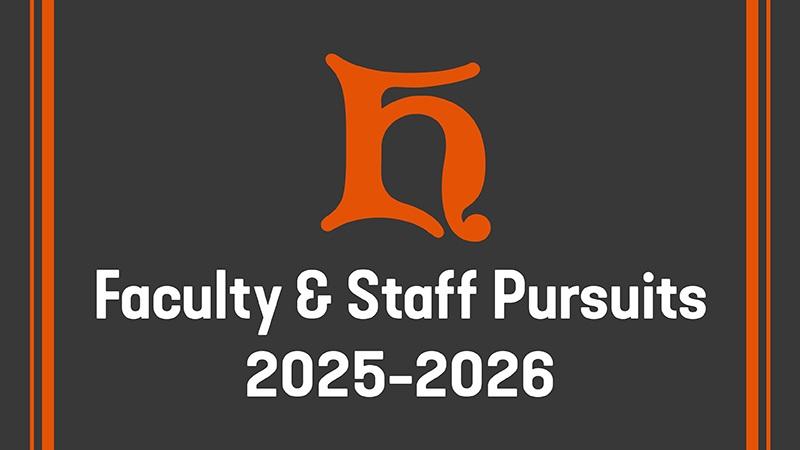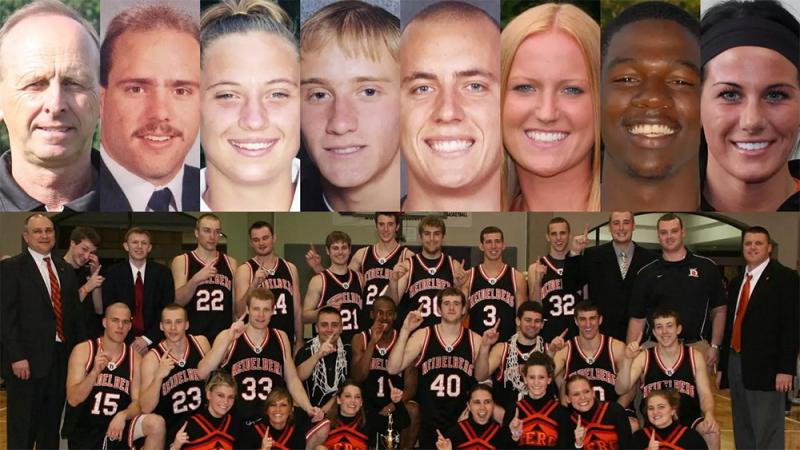Exploring Colorado’s amazing geology up close
Seven Heidelberg students are spending their spring break this week in central Colorado together with their professor, Dr. Amy Berger. This week-long trip is the primary component of their class Regional Field Geology. While there, they are exploring mountains, canyons, fossil beds and mines. Follow the students’ experiences, in their own words.
Day 8 – March 11
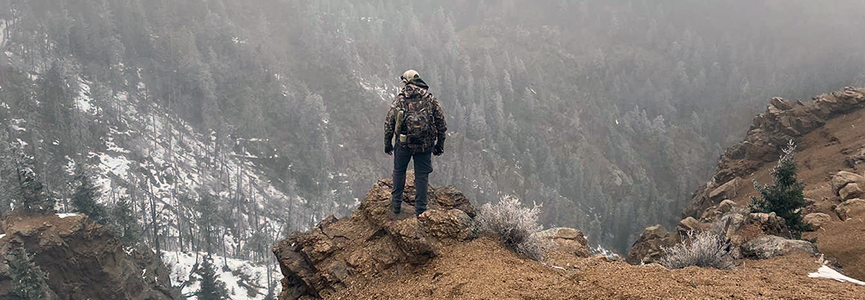
Bridger Cline, senior Environmental Science and Sustainability major
This trip to Colorado was amazing! This was my first time in the Rockies and it has definitely been something I had been looking forward to. The views in Colorado are definitely something to see. Dr. Berger did a great job of choosing sites to see and taking some detours just to have different scenery while driving from place to place. I was really looking forward to going to the top of Pikes Peak and I was a little disappointed when the road was closed due to the weather. Nonetheless, we were able to see everything else we had planned on seeing and many of these locations made up for missing out on Pikes Peak. One thing that really blew me away on this trip was how different the geography is in Colorado. When we were around the Denver area, everything was flat grasslands. By the time we made it to the northern part of the state in the mountains, there were several feet of snow. My favorite part of this trip was the hike up Mount.Cutler. This hike was beautiful because, on the way up the mountain, all of the pine trees were covered with a dusting of snow and there was a heavy covering of fog. This made for some really cool pictures on the top. On the way down, the fog lifted and we had terrific views of the whole city of Colorado Springs. One thing that caught me by surprise on this trip was the campsites we stayed at. I thought we would be staying in rustic cabins but the campgrounds we stayed at were very nice and had everything we needed, including a place to make campfires on the chilly nights. I recommend that anyone who has the opportunity to go on this trip take it. This was a very fun but also educational trip!
Day 7 – March 10
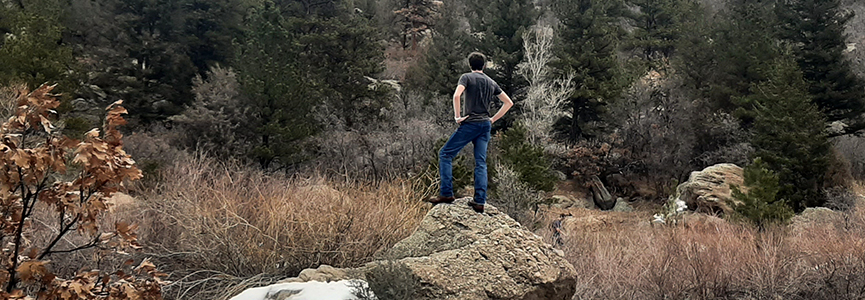
Connor Ladd, junior Environmental Science and Sustainability major
We started the morning off with a decent amount of snow piling up quickly outside. After a fast breakfast, I had the esteemed honor to help push the van out of the snow. We had a decent amount of driving today and before we got through the Berthoud Pass on the Continental Divide (elevation 11,307 feet), it was interesting to drive through the falling snow. But once we passed through the mountains, it was somehow sunny and 55° on the other side. We first stopped at Red Rocks Amphitheater and toured the museum and park. We made another stop at the Dakota Hogback to look at the Morrison and Dakota formations for steeply dipping layers, cross-bedding and ripples. Plate convergence has turned the sandstone and shale layers vertical. We counted about 40 layers in a 220-meter stretch.
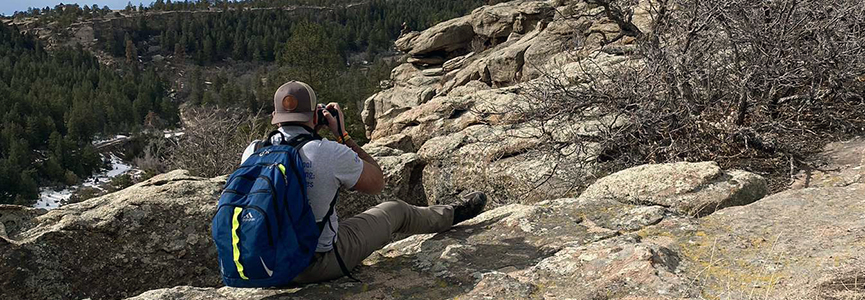
David Harbaugh, senior Environmental Science and Sustainability and Watershed Sciences major
Friday afternoon started with lunch in a picnic area at Castlewood Canyon. We had our normal peanut butter and jelly sandwiches, granola bars, fruit snacks, apples and carrots. After lunch, we made our way to the trailhead where we started our hike. We headed down the trail along Cherry Creek and then up the canyon wall on the other side of the creek. When we made it to the top, there was a herd of 6 mule deer feeding on some trees and grasses. We stopped to watch them for a few minutes and to take some pictures of them before they headed away from the trail. We continued down the trail stopping to take some pictures along the way. We finished up the 4-mile hike around 3:15 p.m. and then headed toward Denver to check into the hotel for the night. After taking all of the bags to the room and emptying out the van, we headed to get dinner at a small Mexican restaurant to end the week.
Day 6 – March 9
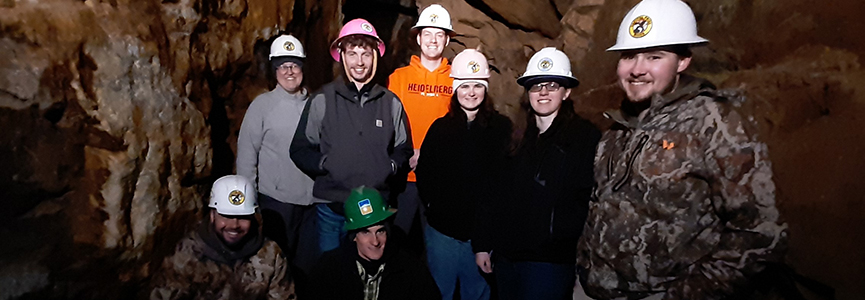
Bridger Cline, senior Environmental Science and Sustainability major
We started our morning with a long three-hour drive. From Cañon City, we drove north to Georgetown, which is a small historic town that sits in a deep valley. While here, we got the chance to tour the Capital Prize Mine. This mine was still active and mined for gold, silver, copper, lead and zinc. During the tour, we learned about what the veins of metal ores look like and how they extract them from the ground. We compared all of the historic techniques to the safer and more efficient techniques used today. We got to experience what it was like to mine with candlelight when our guide turned off all of the lights. Kelly and I had the opportunity to use the pickaxe to knock off a piece of the vein. The tour guide was nice enough to let us keep the pieces we broke off. We were also able to see all of the fine-tuned equipment that is used to sort out the desired metals from the trash rock.
The morning drive to Georgetown had some amazing views. Northbound along Highway 9, the first part of our drive was along lots of rolling hills, grasslands and pasture fields. We even saw several herds of elk and some buffalo during this portion of the drive. The next part of our drive on Highway 9 took us up and over the mountains and through several ski towns that had a decent amount of snow. Once we made it to Georgetown, the terrain started to change. Interstate 70 and Georgetown sit in a deep U-shaped valley that is very rocky. On our way to Grand Lake, north of Interstate 70, the terrain changed again. We took a very steep mountain pass and the snow cover started to increase. By the late afternoon, we made it to Granby, where there is a large reservoir on the Colorado River. We finished up at Grand Lake, which is a natural lake where a glacial moraine has formed a dam.
Day 5 – March 8
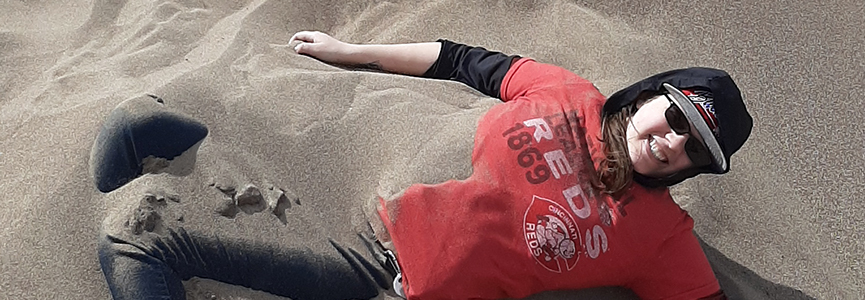
Kelly Peterson and Haley Hoehn, junior Environmental Science and Sustainability majors
We started our day by driving to the Great Sand Dunes and on our two-hour commute, we drove through more of the Royal Gorge before crossing into the Alamosa Valley area, seeing the metamorphic features and through the San Luis Valley. This U-shaped desert valley was formed by a glacier and on the east side is where the Great Sand Dunes are located against the Sangre de Cristo Mountains. The dunes take up about 30 square miles and have dune peaks of over 750 feet. When walking to the dunes, we crossed a dried sandy river bed over to the smaller dunes. As soon as we started walking in the sand, our pace slowed down and when walking up the dunes it was like taking two steps forward and one step backward. The winds, which are what shaped and re-shape the sand dunes, were blowing more than 20 miles per hour and blew sand into our faces. When we climbed further up the dunes, we could see the ripples in the sand from the wind, the San Luis Valley and the mountains around us. When we were finished walking the sand dunes we all had to empty the sand out of our boots, hats, clothes, backpacks, and hair. This was a really unique location and the Great Sand Dunes are the biggest sand dunes located in North America.
Day 4 – March 7
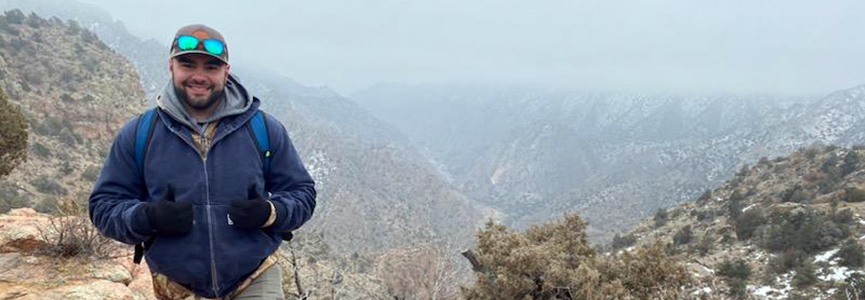
David Harbaugh, senior Environmental Science & Sustainability and Watershed Sciences major
Tuesday started with a little bit of spotty weather delaying our departure from camp for about an hour. However, we made it up to a trail in North Cheyenne Canyon where we headed to a trail that led to the top of Mount Cutler. There was some ice covering the trail on the way up and down the mountain which made the climb a little more challenging. When we made it to the summit, there was a lot of fog that was covering the surrounding mountains but after about 5 minutes of taking in the view and taking pictures, the fog started to lift and we were able to see all of the surrounding mountains for a spectacular view of Precambrian rocks. We then headed back to the van and went to see a waterfall that was up the road a little bit. After we made it back from the waterfall, we headed south and west over the mountains toward Royal Gorge.
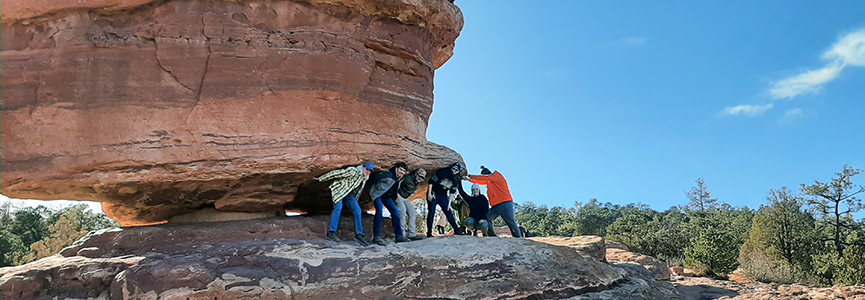
Sean Smith, sophomore Finance major
For the second half of the day, we explored the Royal Gorge. After a quick lunch, we began with a gorgeous 2-mile hike through Royal Gorge Mountain Park. There were incredible plant species all around the trail as well as several overlooks for photos. Along with these, there were several great rock formations with really interesting history behind them. I would be lying if I said I didn’t take a picture every 5 to 10 steps. After we wrapped up our hike we continued on to another side of the Royal Gorge. Here is where some of us took a ride over the gorge which was formed by the Arkansas River. A gondola (which was just like a ski lift) took us right over the top of the gorge. Once again, great photo opportunities while on the ride over the gorge. After the ride in the lift, we had a blast crossing America’s highest suspension bridge. Although it was slightly terrifying, the view was well worth it. Words truly can’t describe all the beauty in this state and we have probably barely scratched the surface. Overall, today was another great day and I look forward to the days to come. Today was also my birthday and I couldn’t have asked for a better way to spend it.
Day 3 – March 6

Haley Hoehn, junior Biology and Environmental Science and Sustainability major
This morning we went to Paint Mines Interpretive Center, east of Colorado Springs. There were several different trails that we could hike, all leading to different amazing sites uncovered by erosion. The major trail that we ended up taking was one that led directly into exposed shales. This location was named because archaeologists theorize Native Americans used the various rock colors for pigments. The first thing that stands out to you is all of the colors. Just standing in one spot you could see five different colored layers on one wall of shale! We returned to our campsite for lunch before heading out for the afternoon.
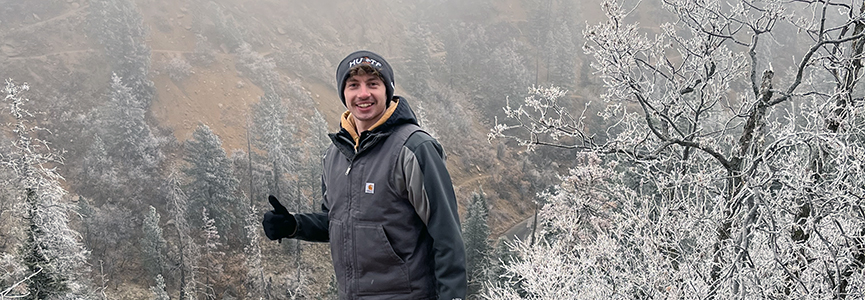
Connor Ladd, junior Environmental Science and Sustainability major
In the afternoon, we visited Garden of the Gods, a Colorado Springs city park. Every rock formation was huge! The rocks we could see were sandstones where we could see coarse and fine grains arranged in different bands from alluvial fan deposits, along with dune sands. We also saw differential weathering at Balanced Rock. Lots of hiking in and around the rock formations, and we even saw some bighorn sheep that got within 10 meters of us! The views from some of the trails overlooking the park and mountain ranges were indescribable. My camera roll is full and it’s only day 2!
Day 2 – March 5
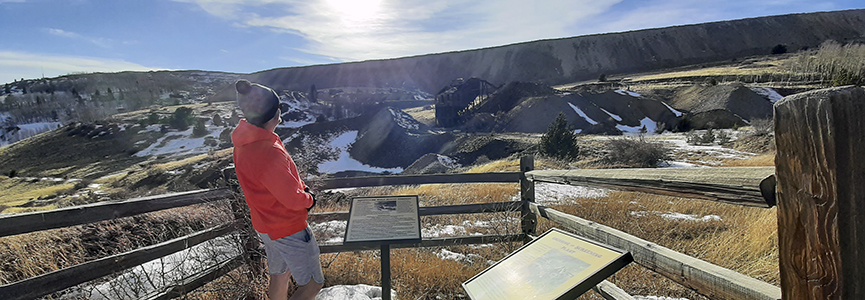
Simon Yochheim, senior Environmental Science and Sustainability major
For the first half of the day, we did a lot of driving to get to our location. During that time, we drove through Colorado Springs and got our first good look at the mountain range. We did make a quick pit stop on the side of the road to draw a quick sketch and take a closer look at some of the billion-year-old granite that forms the main mountain peaks. After our sketch, Brigder gave us a quick presentation on how this granite formed and some of the history behind it. We then looked at a few rock samples and Amy demonstrated how easy it was to crack the rocks apart and take a closer look at the composition of the rocks which included quartz, feldspar and many other minerals that make up the granite in the Colorado mountain range.
Kelly Peterson, junior Environmental Science and Sustainability major
For the second half of our day, we visited Florissant Fossil Beds National Monument. We started out at the visitors center, learning about the Monument and fossils found in the area. Most of the fossils are aquatic plants and insects because the area was formerly a lake. We then walked a trail over to an overlook, where we discovered rocks in this area are volcanic: tuff. We also walked a trail that showed us some of the petrified redwood stumps preserved in the volcanic material. We finished at two stumps that were under a tarp to preserve them for longer. I really enjoyed seeing some of the fossils that have been discovered and it was really cool to see how wide the petrified tree stumps were. After that, we drove to the Cripple Creek Mining district where we got to see two mining towns and the current operations of open pit mining. The change in landscape from the mining was a big difference from the other mountain scenes we had seen earlier in the day. We finished our day with a two-mile hike through the original historic mining operations that still have standing structures.
Day 1 – March 4
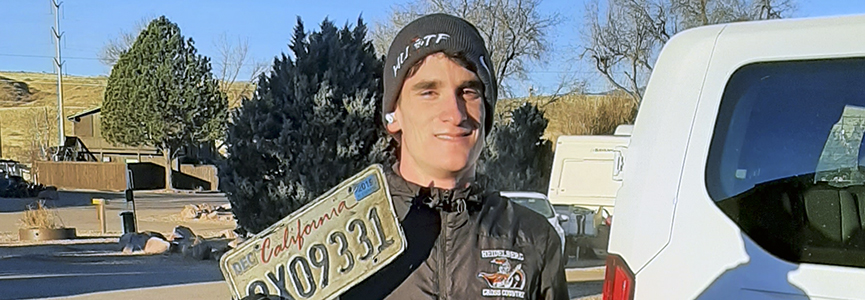
Sean Smith, sophomore Finance major
Day 1: Travel Day! This was a very fun start to the trip for me. I have never flown before so I was excited about the experience. Besides a couple of departure delays, the whole process was incredibly smooth. The views from above the clouds were a surreal sight for me, and before we knew it, we had landed in Denver. There was plenty to see on the way to baggage claim which made the walk very enjoyable. After a quick shuttle to the airport, we secured some McDonald’s and then prepared for the next day. This was a great experience and I am excited for the rest of this trip!

